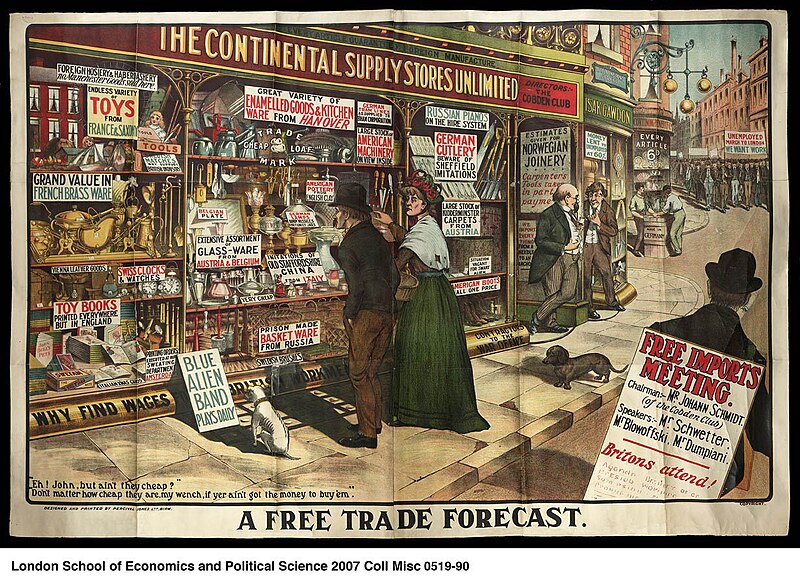Talking Money: how much would Queen Victoria pay for a parure and how much did Jane Eyres earn?
 |
| Image courtesy of Wikimedia Commons |
Hello all, it's been a long time, hasn't it? I hope it's going to get better now:-) Happy New Year to all my dear readers, I hope it treats you all generously!
This is the first part of a series of articles on prices and incomes in the 19th century and I hope at least some of you will find the information useful; it will be periodically updated as I find out more.
This article specifically deals with Victorian period prices as I found them in various publications, websites, 19th century advertisements, women's magazines, household guides, travelling guides and even Old Bailey court proceedings; mostly the prices and incomes apply to a period from 1850s onwards. I will try to mark the years where I remember them.
Various goods including bread, kitchen utensils or clothes were produced in various quality categories; where I know what category it is, I will try to indicate it.
I hope you enjoy:-)
Prices
Food
Bread, 4lbs (1856): 7 1/4 d.
Butter, fresh, in London, per lb (1856): 1s. 6d.
Milk, in London, per quart (1856): 4d.
Coffee, per lb: 2s.
Brown sugar, per lb: 4d.
Eggs, bought in London during winter, per 8-10: 1s.
Eggs, bought at a farm during spring and summer, per piece: 1/2 d.
Cheddar cheese, per lb (1856), best quality: 11d.
Beef sirloin, per lb (1856): 8d.
Mutton leg, per lb (1856): 7d.
Veal leg, per lb (1856): 6d.
Sardines, large box: 1s.
Ham: 8s. 6d.
Tongue: 3s. 6d.
Hare, per lb (1874): 8d.-9d.
Rabbit, per lb (1874): 8d.
Pheasant, per brace (1856): 7s.
Baking powder: 1d. per packet; 6d. per box
Claret, per dozen bottles: 12s.-30s.
Champagne, per dozen bottles: 30s.-42s.
Rough ice, per lb: 1-2d.
Housing - rent
Renting a house in Bloomsbury, per annum: £120
A semi-detached house near New Cross-road (1881), per annum: £40-£60
A house in Granville Park (1881), per annum: £60-£65
A large and handsome house in South Hackney (1881), per annum: £75-£100
An old mansion with garden by the Clapton-road [sic] (1881), per annum: £75-£150
An unfurnished house in Kensington, Argyll Road (1881), per annum: £130-£140
A house in Holland Park (1881), per annum: £340 +
Ditto in Brunswick Gardens (1881), per annum: £100-£150
Ditto near Regent's Park (1881), per annum: £70-£90 (Source: The Suburban Homes of London, 1881)
Utility bills
Telephone subscription, per annum: £20Household items
Porcelain dinner service: 1-100 guineasDessert and tea service: 8/6 - 50 guineas
Toilet set: 3/6 - 20 guineas
12 cut wine glasses: 3/- - 3 guineas
2nd hand silver tea set: £15+
Japanese curtains, per pair: 5s.+
Palmitine ornamental candles, per 1 lb. box: 1s. 6d.
Note paper and envelopes, per box: 2s.+
Mourning note paper and envelopes: 6s.
Pens, per box: 1s.
Carpet sweeper: 12s. 6d.
Washing machine: £6 6s.
6ft kitchen range: £35
Gas cooking stove: £5 5s.
Suite of drawing room furniture: 12-20 guineas
Sewing machine: £3 3s.+
Billiard dining table: £28+
Harmonium: £6+
Pianoforte: 25-85 guineas
Cornet: 30s.+
A good quality doll: 1s. 6d.-2s.
Clothing, shoes, accessories and fabrics
6 pairs of drawers: 12s. 6d.+
6 chemises: 12s. 6d.+
3 nightgowns: 12s. 6d.+
Woolen dressing gown: 12s. 6d.
Flannel dressing gown: 1 guinea
Corset: 7s. 6d.+
Dress shirt: 2s.- 2 guineas
Quilted silk slippers: 3s. 6d.+
Male walking boots: 28s.
Umbrella: 10s. 6d.+
Spectacles: 3s. 6d. - 10s. 6d.
Lady's hat: 5s. 6d.
Lady's boots: 10s. 6d.
Lady's trousseau: from £50
Mourning dress by Jay, plain: 10s. 6d.
Mourning dress by Jay, fancy trimmings: 14s. 6d.+
Garibaldi blouse: 6s.
Harrod's silk tea gown (all the Harrods prices are from 1895): 4.5 guineas
Harrod's silk blouse trimmed with lace: 25s. 9d.
Harrod's silk skirt: 5.5 guineas
Harrod's lady's hat: 2 guineas
Harrod's little girl's sailor frock: 12s. 11d.
Harrod's little girl's lacy hat: 25s.
Worth gown (the simpliest one, 1868): about £64 (1600 francs)
Wolfskin pelisse: £7 10s.-£9 10s.
Sable fur, per skin (this and the following fur prices are taken from a 1911-ish article, I included them here just to give a general idea): £70-100
Sable coat, of esp. fine skins: £3000
Ditto, average skins: £1500
Sable coat collar: £200-£250
Large sable muff of 8 skins: £560
Ermine coat, best quality: £250-£300
Ditto long stole: £100
Ditto short tie: £8-£14
Ditto big muff: £15-£25
Chinchilla coat, best quality: £2000
Ditto three-quarter coat, best quality: £1000
Ditto muff, best quality: £500-£650
Black silk, per yard at 24 inches (61 cm) of width: 2s. 11d.-12s. 6d.
Irish poplin, per yard: 5s. 6d.-5s. 9d.
Beauty products
A bottle of Irish perfume: 2s. 6d.
Kalydor (toilet) soap: 4-6d. per tablet
Hair cream: 1s. 6d.+
Beetham's extract from glycerine and cucumber (to make skin white and soft), per bottle: 1s.-4s. 6d.
Atkinson's Essence of White Rose perfume, a small bottle, per dozen: 16s.
Ditto, a large bottle, per dozen: 28s.
Jewellery
Man's silver pocket watch: £3 3s.+
Lady's silver watch: £2 2s.+
Man's gold watch: 12-20 guineas
Lady's gold watch: 10-20 guineas
Queen Victoria's emerald parure: £20 000
Ditto, but made of diamonds: £15 000
Imitation gold jewellery:
wedding ring: 1s.
brooch: 3s.
earrings: 3s.
cross: 1s. 8d.
locket: 1s. 6d.
shirt studs: 1s. 3d.
Miscellaneous
Music lessons by a fashionable master: 1 guinea per lesson
Photo portrait: 2s. 6d.
Portrait by Millais: 2000 guineas +
Opera ticket during the Season: 1 guinea for the stalls, 2-12 guineas for the boxes
Book of Millais's Illustrations: 16s.
A copy of The Times: 3d.
Flowers (a bouquet?): 2s.
A bouquet of violets: 1d.
1st class funeral: £28 10s.
Turkish baths ticket: 2d. 6d.
A drachm and a half of laudanum: 2d. (2d. worth is a large quantity, even for a person who is constantly using it, according to a chemist in 1877)
Incomes
Matchbox maker, per 100 boxes: 2d.
A doll dresser working at home, per dozen doll outfits of cheap quality: 1 1/2 d. - 8d.
A doll dresser working in a company, per week: 10-14s.
West End shopgirl, per annum (1895): £25 + £3-£6 commissions monthly; however, this is the higher figure and less than £15 a year is more likely
A male shop assistant (apprentice) in a grocery shop, per annum: £26
Junior clerk at solicitor's office, per annum: £52
A certified teacher in village school (1840s): £30-£40
A teacher in a London board school (1890s), woman: £85, a yearly rise of £3
Ditto, man: £95, a yearly rise of £5
Butler (in a family with £1000 a year, 1856): £30-£45
Housemaid (1856):10 to 16 guineas
Cook (1856):10 to 24 guineas
Lady's maid (1856): 18 to 25 guineas
Young lady's maid (1856): 12 to 18 guineas
Maid-of-all-work (1856): 4 to 10 guineas.
Lady clerk in the Assurance Company, per annum: starting salary of £32, increases yearly to final £100
Lady accountant, per week: 15s. in her first position, then 18-25s.
Clergymen: That rather depends. The father of the famous Brönte sisters earned £200 a year; in 1881, the Greenwich parish church gave living of £700 and in the same year, the church of St. John in Blackheath yielded £600 a year, while St. Paul's in Hamstead yielded £1026.
A word on governesses
According to Angeline Goreau, the most a governess could hope for was £100 a year; the usual upper limit however seems to be some £30-£45 pounds. The lower is as little as £12 - for comparison, that is how much a kitchenmaid would make. The fictional Jane Eyre earned £30 per annum; as Goreau states, Charlotte Brönte in her last governess post earned £20.
How about the expenses though? Agnes Grey, the eponymous heroine of Anne Brönte's novel estimates she might need £20 to cover them if she is very frugal; the Fraser's Magazine estimated £27 of expenses to be the bare minimum.
The breakdown in the magazine is thus:
£16 for clothes
£6 for washing
£3 for postage and stationery
£2 for casualties
Medical and traveling expenses were not put into account in this estimate. (Source: Agnes Grey, Introduction by Angeline Goreau)














2 komentářů
Dear Rosa,
ReplyDeleteGood to see you back online! Gee, I'd rather not have worked as a doll dresser in Victorian times. Could have been interesting work but so poorly paid...
Very best,
Natalie
*hugs*
DeleteYes, it is rather poorly paid - though I think I'd still prefer it over doing, say, a maid of all work, brrr *shudders* At least doll dressing was a creative work, though I suppose, in a sense a drudgery also...